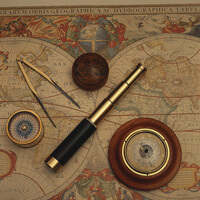Were you born with the mission of saving the whales? Do you actually know what you want to be when you grow up? Are you one of those people who can come up with a clear and confident answer when asked what you’re “interested in”? If you answered “yes” to any of the questions above, then stop reading this article right now, because I am most likely telling you how to find something you have known for a long time. If you’re like me, however, you are pretty much lost when it comes to choosing a major or career.
A little history…
This summer, I completed a series of aptitude tests given by the Johnson O’Connor Research Foundation in hopes of answering the questions I just asked you. Although the results did not direct me toward any one career, they gave me insights about my abilities that made me realize just how many opportunities are available to me.

The Johnson O’Connor aptitude tests can be taken at eleven offices in the U.S. and measure about twenty different aptitudes. Their creator, Johnson O’Connor, began developing the tests in 1922 while working at General Electric to assess what kind of work would make each employee the most productive. The first test measured each worker’s dexterity to determine who would be the most efficient in jobs requiring fine motor skills. The employees began demanding more thorough tests for their children to help them find jobs that suited them as well, leading to the foundation of the Johnson O’Connor Research Foundation/Human Engineering Laboratory in Boston in 1939. Over time, Johnson O’Connor collected enough data from people satisfied by their jobs to create specific “profiles” for hundreds of different careers, allowing the foundation’s staff to match up the test taker’s profile with careers in which he or she would probably succeed.
Career satisfaction is the goal
Most people would rightly assume that those who are satisfied by their work are good at what they do. The goal of the testing is to measure your aptitudes so that you know what kinds of work would be satisfying. Some of the aptitudes the tests measure are visual, like observation, or color discrimination, the ability to tell apart two very similar colors. Other aptitudes are physical, like finger dexterity, which is measured by timing how quickly you can put pins into tiny holes. Some aptitudes, like “ideaphoria,” which is the ability to quickly come up with ideas, or foresight, the ability to envision reaching a distant goal, are measured using seemingly unrelated tasks.
If your score for a particular skill is higher than that of 70% of people in your age range, the skill is considered one of your aptitudes. Aptitudes are innate—you can’t develop or improve them (except for vocabulary, which is knowledge), and it is no better to have one than another. In fact, not having an aptitude can be just as useful in a job as having one. A secretary with ideaphoria would probably be easily distracted from the repetitive work that kind of job sometimes requires, although a teacher without it could bore his or her students to death.
A family friend recommended this testing to my mother when she was deciding whether or not to go back to work after I entered high school. My mom was shocked by the results of her tests—she had the aptitudes of neither a stock analyst nor a writer, two of her former careers, but those of an interior designer! My brother, who was considering studying law or business in college, took the tests as well, and discovered that his combination of ideaphoria and structural visualization would make banking very dissatisfying. He decided to study robotics and computer science instead, which would use his memory for designs and his ability to think in three dimensions. My dad, who never took an art class, discovered that his color discrimination was better than that of 95% of the population. I was the only one, it seemed, who had not yet uncovered some dormant talents.
But what should I be?
Curious and a little nervous, I went to the testing center at Broadway and Rector for two afternoons this summer to complete the testing myself. After the testing, I entered Christine’s office to receive my results, expecting to be handed a little card printed with a one-word future. What I found instead was a packet of aptitudes and scores. Finger dexterity: 40th percentile. Number memory: 75th percentile.
After swimming for a few minutes in the list of unfamiliar scores and percentiles, wondering what it all could possibly mean, the questions I had always wondered about myself began to bubble up to Christine. If I observe my surroundings so carefully, why can’t I ever find my wallet? Too many ideas distract me. Why am I so clumsy at team sports? My grip is weaker than that of 95% of the population. Answering my questions one by one, Christine looked at me from behind her blue-rimmed glasses like a doctor diagnosing a patient’s common cold. Then she asked me what I wanted to be when I grew up.
I said teacher, or a writer, or maybe a psychologist. She nodded. “You have the skills to do any of those things, Lucy. But you wouldn’t be satisfied with any one of them. Think bigger. What’s something that you’re passionate about?”
Think bigger. I suddenly realized that I had viewed careers, majors, interests, and hobbies as ways to fill up time, titles to write on applications. Christine was not saying that any of the careers I had listed were somehow unworthy, but she was encouraging me to not be afraid to demand more of the world, to see work as the first step toward change.
No matter what I got myself involved in, Christine continued, I seemed to put myself at the head of the group. Looking at the list of after-school activities I had given her, she remarked how many of them involved community service. “You seem to have a heart for social justice. Instead of running around from project to project, have you thought about directing your energy toward one cause?” I liked the term social justice—I had never thought about service projects as something to be “good at” or as anything other than stuff I did after school, but the more I thought about it, the more I saw that my organizational and leadership skills made me useful for such projects. The cause I cared most about, I said, was education.
Christine became more animated, her eyes flashing with excitement as she exhorted, “Get involved! Start a movement! Your love for organization, your leadership skills, and your narrow focus on anything you do make you an ideal candidate for helping a cause like education.” Although I was encouraged by her enthusiasm, I did not see a clear career path.
Starting my journey
Finish high school, she proposed. That, at least, I was sure I could do. Go to college. Find a group and a subject I want to teach, and become an expert in the field of education. Then build a team that can contribute to efforts at education reform. And, of course, tell my friends what I learned. Everyone has talents that are distinctly his or her own and that are essential in today’s world, but to use one’s talents, one must first know what they are.
Of course, you do not need to know your exact scores—fascinating as they may be—for each of Johnson O’Connor’s aptitudes to decide what you want to be. Chasing the dreams of others, however, is not an effective way to answer such an important question. Instead, I would invite you to ask yourself what you are passionate about.
















